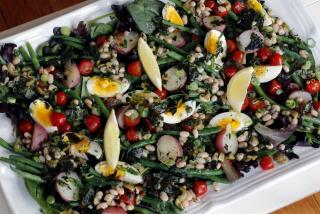Taking an Analytical Approach to Your Diet
- Share via
We often get letters from readers who want some help analyzing their diets. This isn’t a particularly difficult thing to do. There are lots of questionnaires and charts that dietitians use to accomplish this.
But it is time-consuming and sometimes, to be perfectly blunt, not terribly useful. Now that computers can do most of the work, the tedious part has been taken care of. Nonetheless, the old adage still applies: GIGO--garbage in, garbage out. The accuracy and usefulness of the information you give the computer or any other diet analysis tool will determine how meaningful the results will be.
The best dietary analysis tool we have seen on the Web is put together by the U.S. Department of Agriculture. This is a logical pairing because the department maintains the most comprehensive database of food composition tables anywhere.
Before the dawn of the computer, we used to purchase those USDA tables (the latest printed version that we have takes up a bookcase shelf or two). Now, it’s all just a click away.
But what kind of information does the computer or the dietitian need? Both will ask for a day’s intake of food. But which day should you pick? The day you fill out the questionnaire, when you’re probably on your best dietary behavior? A weekday when you’re at work and eating lunch out? A vacation, when you probably indulged a bit? A busy day? A slow day?
Pick an average day. One that is most typical of the way you normally eat. Don’t lie to the computer or the dietitian by giving simply what you think are the appropriate responses. And don’t pick a day when you went through an entire bag of Cheetos or Oreos. In the best of all possible worlds, dietary analysis would be done by keeping a monthlong food diary and averaging the amounts and types of foods eaten. But in the real world, most people use the 24-hour recall method.
Pay attention to portion sizes. Be aware that a muffin can be a big muffin or a small muffin, that 3 ounces of chicken is far different from half a chicken. Get as close as you can to the standard sizes listed and then multiply by the number of servings this represents. Give brand names if possible. In combined foods, be specific, but if you can’t find a similar product in the lists of foods, break it down into major ingredients.
Whether you work with a dietitian to analyze your diet or do it yourself, the information you get is approximate and should be used as a guideline to help you improve your overall diet. Don’t get too hung up on what you eat in a single day. Think of the big picture and your diet as a whole.
The Web site we recommend is https://www.usda.gov/cnpp. It will compare your intake to the food pyramid and give you a score based on the information you provide. It will also highlight the amount of fat, cholesterol and sodium you consumed, as well as the other nutrients for which there are recommended intake levels. It’s kind of fun to do it over a series of days to see the differences. It’s also worth the trip to the USDA home page, https://www.usda.gov, to find other interesting information about health and food.
If you want to have your diet analyzed and get some solid nutritional advice, but don’t have access to a computer, call your local chapter of the American Dietetics Assn. to get the name of a registered dietitian in your area. Your physician may also be able to recommend someone.
Although the computer has made getting health information a lot easier, it has also opened the floodgates to misinformation and downright quackery. There are thousands of health-related Web sites, and they are only now starting to be carefully evaluated by outside agencies. Be cautious about which sites you rely on for important information about your health. If the main purpose of a Web site seems to be selling something and all their health advice leads you toward a purchase, get a second or third opinion.
Here’s a partial list of Internet sources that provide good nutritional and health information:
American Cancer Society: https://www.cancer.org.
American Council on Fitness: https://www.acefitness.org.
American Dietetic Assn.: https://www.eatright.org.
American Heart Assn.: https://www.americanheart.org.
Food and Drug Administration: https://www.fda.gov.
Government Healthfinder: https://www.healthfinder.gov.
Governors Council on Physical Fitness and Sports: https://www.physicalfitness.org.
Harvard University health information: https://www.intelihealth.com.
International Food Information Council: https://www.ificinfo.health.org.
Mayo Clinic Oasis: https://www.mayohealth.org.
Medline (access to published scientific information) https://www.nlm.nih.gov/databases/freemedl.html.
National Cancer Institute: https://www.cancernet.nci.nih.gov.
National Institutes of Health: https://www.nih.gov.
Quackwatch (a guide to health fraud and quackery): https://www.quackwatch.com.
Tufts University Nutrition Navigator: https://www.navigator.tufts.edu.
USDA Food Data: https://www.usda.gov/cnpp.
And of course:
Berkeley Wellness Letter: https://www.berkeleywellness.com.
Dr. Sheldon Margen is a professor of public health at UC Berkeley; Dale A. Ogar is managing editor of the UC Berkeley Wellness Letter. Send questions to Dale Ogar, School of Public Health, UC Berkeley, Berkeley, CA 94720-7360, or e-mail to daogar@uclink4.berkeley.edu. Eating Smart appears the second and fourth Mondays of the month.
More to Read
Eat your way across L.A.
Get our weekly Tasting Notes newsletter for reviews, news and more.
You may occasionally receive promotional content from the Los Angeles Times.










